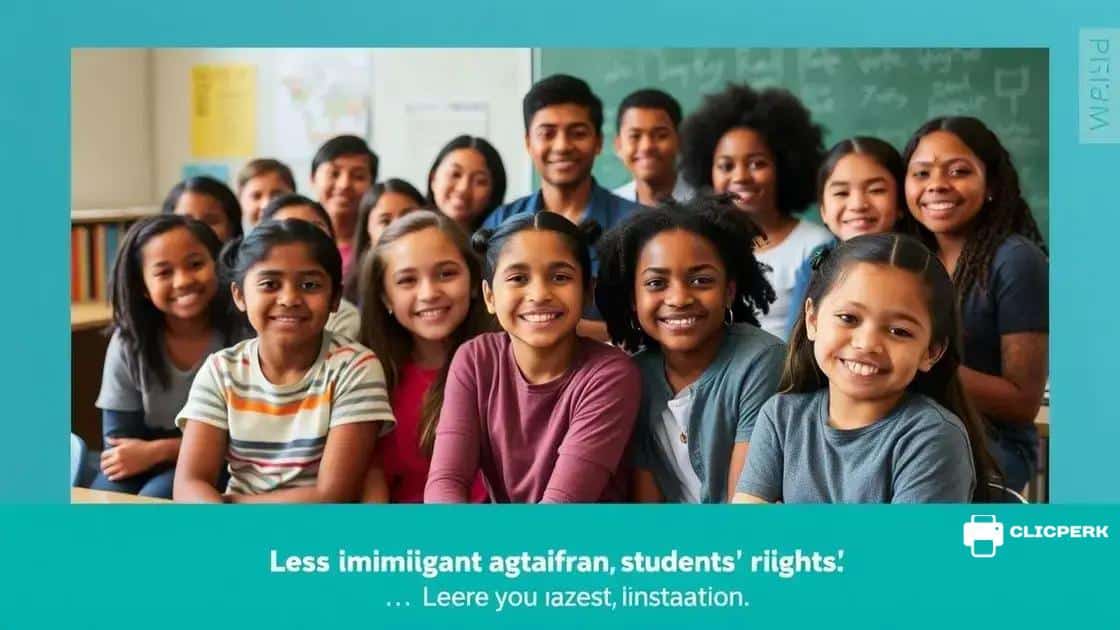Safeguards upholding immigrant students’ rights in education

Safeguards upholding immigrant students’ rights in education ensure equitable access to schooling, protect against discrimination, and support the unique needs and cultural backgrounds of these students and their families.
Safeguards upholding immigrant students’ rights in education are crucial to ensure these students receive fair treatment and opportunities in schools. Have you ever wondered how these protections can shape their educational journeys?
Understanding the rights of immigrant students
Understanding the rights of immigrant students is vital for their academic success and emotional well-being. Every student deserves to feel safe and supported in their learning environment. Strong protections exist to ensure that immigrant students can access education without fear of discrimination.
Key Rights of Immigrant Students
Many laws provide specific rights for immigrant students. These rights help create a welcoming school environment. Here are some important protections:
- Equal access to education: All students, regardless of their immigration status, have the right to attend public schools.
- Protection against discrimination: Schools cannot discriminate based on immigration status.
- Confidentiality: Schools must keep students’ immigration status confidential to protect their privacy.
- Support services: Immigrant students are entitled to the same support services as their peers, including counseling and tutoring.
It’s essential for schools to understand and follow these laws. Proper training for teachers and staff can help. When educators are informed, they can create a positive atmosphere for all students.
Why Rights Matter
When immigrant students understand their rights, they can advocate for themselves. Knowing their rights promotes confidence and engagement in school activities. Immigrant students with a good grasp of their rights are more likely to participate fully in school.
Encouraging open discussions about rights in the classroom is beneficial. When teachers create space for questions, students feel empowered. This empowerment leads to better academic outcomes.
Key legislation protecting student rights
Key legislation protecting student rights plays a crucial role in ensuring that all learners, especially immigrant students, have access to education without fear or discrimination. Various laws set important standards for schools to follow, ensuring that every student is treated fairly.
The Individuals with Disabilities Education Act (IDEA)
IDEA guarantees special education services for students with disabilities. This law requires schools to tailor educational programs to meet individual needs. Immigrant students eligible for these services are entitled to receive appropriate support to ensure their educational success.
Title VI of the Civil Rights Act
This law prohibits discrimination based on race, color, or national origin in programs receiving federal financial assistance. It is key for protecting the rights of immigrant students. Schools must ensure that these students are not treated unfairly due to their background.
- Supports language accessibility: Schools must provide support for students who are English language learners.
- Financial aid: Schools should not deny aid based on immigration status.
- Parental involvement: Immigrant parents have the right to engage in their child’s education.
Understanding these laws helps schools create a supportive environment. Training staff on these legislations ensures that immigrant students receive the care and education they deserve.
The Every Student Succeeds Act (ESSA)
ESSA builds on previous educational reforms and aims to reduce the achievement gap among students. It emphasizes inclusivity and provides resources for schools to support all students, including those from immigrant families. Under this act, schools are accountable for ensuring each student receives a high-quality education.
Awareness of such laws is essential. When students know their rights, they can better advocate for themselves. This awareness promotes a more inclusive and supportive school culture, which ultimately benefits everyone’s learning experience.
Challenges faced by immigrant students

Immigrant students often face a variety of challenges that can impact their educational experiences. These barriers can make it difficult for them to succeed in school and feel integrated into their communities. Understanding these challenges is essential for creating a supportive learning environment.
Language Barriers
One of the most significant obstacles for immigrant students is language proficiency. Many of these students may speak limited English or may not be familiar with the language at all. This can hinder their ability to participate in class discussions, complete assignments, and connect with peers.
- Difficulty understanding lessons: When students do not grasp the language, they struggle to understand what teachers are saying.
- Limited communication: Language barriers can prevent students from expressing their needs or asking for help.
- Feeling isolated: Not being able to communicate effectively can lead to feelings of loneliness.
Addressing language challenges with support programs and resources is crucial. Bilingual education and ESL (English as a Second Language) classes can help bridge the gap.
Cultural Differences
Cultural differences also play a role in the experiences of immigrant students. They may encounter unfamiliar customs and social norms that can be overwhelming. Adjusting to a new culture may create stress for these students.
Adapting to new education systems is another challenge. Each country has different expectations for student behavior, learning styles, and academic standards. This transition can be disorienting and frustrating.
Schools can foster understanding by promoting cultural awareness. Engaging students in discussions on cultural diversity enriches the learning environment and helps immigrant students feel valued and recognized.
Emotional and Psychological Challenges
Immigrant students may also experience emotional and psychological challenges. Many have faced significant life changes that can affect their mental health. Issues like anxiety, depression, and homesickness are common as these students navigate their new environment.
Support from counselors and mental health professionals is vital. Schools should provide resources for students to access help when needed. Creating a safe space for sharing feelings can encourage students to discuss their experiences openly.
Effective practices in schools for inclusivity
Effective practices in schools for inclusivity are essential to support all students, especially immigrant students. These practices foster an environment where every student feels valued and has the opportunity to succeed. Collaborative efforts among educators, students, and families contribute greatly to this goal.
Creating a Welcoming Environment
Schools should prioritize creating a welcoming atmosphere. This can be accomplished through various means. For example, displaying multicultural artwork and resources helps students see their backgrounds reflected in the learning space.
- Incorporating diverse curricula: Teaching about different cultures encourages understanding and respect.
- Using inclusive language: Staff should model inclusive language to foster a sense of belonging.
- Celebrating cultural events: Organizing events that recognize different cultural traditions makes all students feel included.
These actions show immigrant students that their identities are acknowledged and respected. As a result, students can engage more fully in their education.
Providing Language Support
Language support is critical for immigrant students who may face challenges in communication. Implementing bilingual programs and providing resources like translation services can help bridge language gaps.
Schools can also encourage peer-to-peer support by pairing native English speakers with English language learners. This mutual learning experience benefits both groups and enhances social connections.
Professional Development for Educators
Training teachers and staff on cultural competency and inclusivity practices is vital. Workshops and ongoing professional development help educators understand the challenges faced by immigrant students and equip them with the tools needed to provide effective support.
Encouraging collaboration among teachers across different subjects can foster innovative strategies for inclusiveness. This collaborative mindset can enhance the educational experience for all students.
By employing effective practices, schools can build an inclusive community that promotes the success of every student, regardless of their background or language abilities.
Advocacy and support for immigrant families
Advocacy and support for immigrant families are crucial to ensure their rights are respected and their needs are met within the educational system. These efforts help immigrant students and their families navigate challenges and access resources essential for their success.
Community Resources
Many organizations provide resources to support immigrant families. These can include legal assistance, educational programs, and mental health services. Families often face barriers in understanding the educational system and knowing their rights.
- Legal aid: Many communities have organizations that offer free or low-cost legal support to help families understand their rights.
- Educational workshops: Workshops can empower families with knowledge about the school system and available services.
- Cultural orientation: Programs that introduce families to cultural differences in the U.S. education system can ease transitions.
Access to these resources ensures families are informed and can advocate effectively for their children.
Building Trust and Relationships
Creating strong relationships between schools and immigrant families is essential. Building trust helps families feel welcome and encourages active participation in their children’s education.
Schools can arrange regular meetings and events that invite families to engage with educators. This involvement can foster a sense of community and promote collaboration towards common goals.
Effective Communication
Effective communication is critical in supporting immigrant families. Schools should provide information in multiple languages to reach all families.
Using interpreters and translating materials ensures that families fully understand events, policies, and their children’s progress. This approach leads to more engaged parents and allows for a collaborative effort in supporting immigrant students.
By prioritizing advocacy and support, communities can help immigrant families thrive. Empowered families are better equipped to navigate challenges and work together with schools for the benefit of their children.
In conclusion, supporting immigrant students and their families is vital for their success in education. By understanding the challenges they face and implementing effective practices, schools can create a welcoming environment. Advocating for their rights and providing necessary resources empowers these families and fosters inclusivity. Together, we can build a brighter future for all students, ensuring that every child has the opportunity to thrive.
FAQ – Frequently Asked Questions about Supporting Immigrant Students
What resources are available for immigrant families?
Many organizations offer legal aid, educational workshops, and cultural orientation to help immigrant families navigate the school system.
How can schools create an inclusive environment for immigrant students?
Schools can create inclusivity by displaying multicultural materials, hosting cultural events, and using inclusive language in communication.
What role do teachers play in supporting immigrant students?
Teachers can support immigrant students by receiving training in cultural competency and fostering open communication to understand their needs.
Why is effective communication important for immigrant families?
Effective communication ensures that immigrant families understand school policies and their children’s progress, which fosters trust and engagement.





